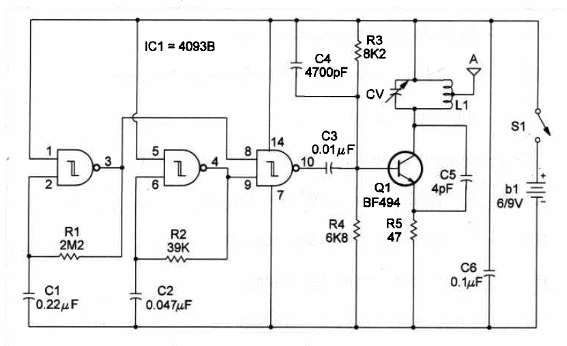This FM wireless transmitter produces a beep that can be tuned on any dead point of the FM broadcast band.
The circuit can be used as a Iocalizer when attached to objects or persons. You also can use it as a wireless alarm.
The signal can be tuned on common FM radios in a range up to 150 feet.
Alterations for a far-reaching version are given below.
The circuit produces an intermittent beep of about 1 Hz.
An audio tone is generated by IC1b (pins 5, 6 and 4) and its frequency is determined by R2 and C2.
You can easily alter this frequency by adjusting R2.
Resistor values between 22,000 and 100,000 Ω can be experimented with or, if you prefer, 100,000 Ω in series with 10,000 Ω can replaoe R1.
Repetition rate is per R1 and C1. Vaiues are variable.
For C1 values between 0.15 and 1 µF can be tried. It is important to test for the ideal value of this component, depending on the intended application.
The schematic diagram of the wireiess beeper is shown in Figure 1.

Three gates of a 4093 IC are used to generate the low-frequency signals, and one RF transistor is used to generated the high-frequency signaL
Components placement on a homemade printed-circuit board is shown in figure 2.

Placement is critical for the high-frequency stage.
Capacitors in this stage should be ceramic.
L1 consists of four turns of No. 18 or 20 wire on a 1/2 in. form without a ferrite core.
The antenna is formed by a pieóe of bare wire between 5 and 10 inches Iong.
lt can be connected to any tap on the coiL Experiment to get better performance.
The power supply current drain is about 10 mA.You can use four AA-cells or a 9V battery to power the transmitter.
For a wireless alarm, S1 can be replaced by the contacts of a relay. The relay is used to interface the alarm with the transmitter in this application.
Another way to interface an alarm with the transmitter is to connect relay contacts in series with C5 or between points A and B in the schematic. See more detals in Ideas to Explore.
Wireless Beeper
IC1 - 4093 CMOS Integrated Circuit
Q1 - BF494 or equivalent NPN RF silicon transistor
L1 - coil - see text
CV - trimmer capacitor - 20 to 40 pF maximum
R1 - 2,200,000 ohm, ¼ W, 5% resistor
R2 - 39,000 ohm, ¼ W, 5% resistor
R3 - 8,200 ohm, ¼ W, 5% resistor
R4 - 6,800 ohm, ¼ W, 5% resistor
R5 - 47 ohm, ¼ W, 5% resistor
C1 - 0.22 µF ceramic or metal film capacitor
C2 - 0.047 µF ceramic or metal film capacitor
CS - 0.01 µF ceramic or metal film capacitor
C4 - 4,700 pF ceramic capacitor
05 - 4.7 pF ceramic capacitor
C6 - 0.1 µF ceramic capacitor
A - antenna - see text
S1 - SPST slide or toggle switch
B1 - 6 to 9V - four AA cells or 9V battery
Ideas to Explore
To get better performance or to learn more about the circuit:
You can control the beeper oscillator by IC1, pins 1 and 5. Put these pins together. When in a high logic level the circuit produces intervalled beeps. When in a low logic level the circuit stops.
Replace Q1 by a 2N2218. Power the circuit with a 12 V power supply. Signals can now be tuned from distances up to 1,500 feet. A 5- to 6-foot antenna will increase the range of the transmitter.
Science projects or uncommon applications:
House this circuit in a box and tell someone to hide it. You’ll find it by using a small FM receiver.
The transmitter can be used to track animals by fixing it on a collar.
You also can use the transmitter to monitor remote sensors in experiments. The circuits can power ON the transmiter or trigger the oscillator as indicated above.



